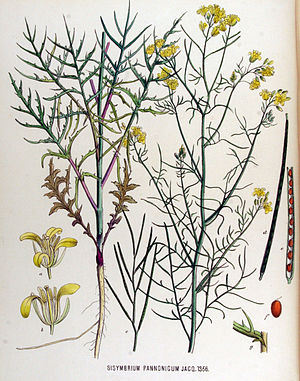Hungarian rocket
| Hungarian rocket | ||||||||||||
|---|---|---|---|---|---|---|---|---|---|---|---|---|

Hungarian rocket ( Sisymbrium altissimum ), illustration |
||||||||||||
| Systematics | ||||||||||||
|
||||||||||||
| Scientific name | ||||||||||||
| Sisymbrium altissimum | ||||||||||||
| L. |
The Hungarian rocket ( Sisymbrium altissimum ), and High rocket called, is a species of the genus rauks ( Sisymbrium ) within the family of the cabbage family (Brassicaceae). It is widespread in Eurasia and a neophyte in North America .
description
The Hungarian rocket grows as an annual wintering or summer annual herbaceous plant that reaches heights of 30 to 80 centimeters. It is hairy at the base ( trichomes 1.5 to 3 mm long).
The leaves are initially arranged in a basal rosette and later alternately distributed on the stem. The basal leaves are oblique saw-shaped, with four to nine lanceolate to triangular sections per side. The mostly sessile upper and middle stem leaves are pinnate, with two to six linear leaf sections on each side.
The flowering period extends from May to July. The hermaphrodite flowers are fourfold. The sepals , which protrude widely during anthesis, are 4 to 6 mm long, the two outer horns at the tip. The four petals are light yellow.
The pods are 6 to 10 cm long and stand on stems 5 to 12 mm long of the same thickness.
The species has chromosome number 2n = 14.
ecology
The Hungarian rocket is a hemicryptophyte and therophyte .
The plant, which is rigid and light at the time of fruiting, can be torn out of the ground as a whole and then spread out as a steppe runner . The numerous seeds are embedded in hollows of the pods and gradually fall out when shaken.
Occurrence
The Hungarian rocket is a continental floral element . Their original distribution ranges from Central Asia , India and Pakistan to Eastern and Southeastern Europe . She became a neophyte in many countries, such as in North America, New Zealand or Hawaii, but only recently. The Hungarian rocket immigrated to Central Europe from continental Eastern Europe . It has been proven in Brandenburg since around 1830. A particularly strong expansion took place with the expansion of the railway network.
The Hungarian rocket colonizes debris areas, roads and dams in Central Europe, especially in the northeastern part of the lowlands, in the northern part of the low mountain range, in the Rhine-Main area, in the Franconian Alb and its foreland, in western Switzerland and in the Vienna basin. It is rare and mostly inconsistent in its locations. In the Allgäu Alps it rises in the Tyrolean part on the way from Nesselwängle to Gimpelhaus up to 1200 m above sea level.
The Hungarian rocket usually thrives on loose sand or gravel soils , which should, however, be rich in nutrients and, above all, nitrogenous . In Central Europe it is a character species of the Lactuco-Sisymbrietum altissimi from the Sisymbrion association.
ingredients
The seeds contain plenty of erucic acid .
Taxonomy
The first publication of Sisymbrium altissimum was done by Carl von Linné . Synonyms for Sisymbrium altissimum L. are: Sisymbrium sinapistrum Cr. , Sisymbrium pannonicum Jacq. The specific epithet altissimum means very high.
literature
- Otto Schmeil , Jost Fitschen (greeting), Siegmund Seybold: The flora of Germany and the neighboring countries. A book for identifying all wild and frequently cultivated vascular plants. 95th completely revised u. exp. Edition. Quelle & Meyer, Wiebelsheim 2011, ISBN 978-3-494-01498-2 .
- Henning Haeupler , Thomas Muer: picture atlas of the fern and flowering plants of Germany (= the fern and flowering plants of Germany. Volume 2). 2nd, corrected and enlarged edition. Published by the Federal Agency for Nature Conservation. Ulmer, Stuttgart 2007, ISBN 978-3-8001-4990-2 .
- Ruprecht Düll , Herfried Kutzelnigg : Pocket dictionary of plants in Germany and neighboring countries. The most common Central European species in portrait. 7th, corrected and enlarged edition. Quelle & Meyer, Wiebelsheim 2011, ISBN 978-3-494-01424-1 .
- Oskar Sebald, Siegmund Seybold, Georg Philippi (Hrsg.): The fern and flowering plants of Baden-Württemberg. Volume 2: Special part (Spermatophyta, subclass Dilleniidae): Hypericaceae to Primulaceae. 2nd expanded edition. Eugen Ulmer, Stuttgart 1993, ISBN 3-8001-3323-7 .
Individual evidence
- ↑ a b c d e Hungarian rocket. In: FloraWeb.de.
- ↑ a b Rothmaler: Exkursionsflora von Deutschland , Spektrum Akademischer Verlag Heidelberg, Berlin, 20th edition 2011 ISBN 978-3-8274-1606-3 , page 547
- ↑ a b Erich Oberdorfer : Plant-sociological excursion flora for Germany and neighboring areas . 8th edition. Page 475. Stuttgart, Verlag Eugen Ulmer, 2001. ISBN 3-8001-3131-5
- ↑ Erhard Dörr, Wolfgang Lippert : Flora of the Allgäu and its surroundings. Volume 1, IHW, Eching 2001, ISBN 3-930167-50-6 , p. 571.
- ↑ data sheet with photos.
Web links
- Hungarian rocket. In: FloraWeb.de.
- Distribution map for Germany. In: Floraweb .
- Sisymbrium altissimum L. In: Info Flora , the national data and information center for Swiss flora . Retrieved October 29, 2015.
- Distribution in the northern hemisphere
- Thomas Meyer: Data sheet with identification key and photos at Flora-de: Flora von Deutschland (old name of the website: Flowers in Swabia )
- Wanted poster with photos.
- Data sheet.


